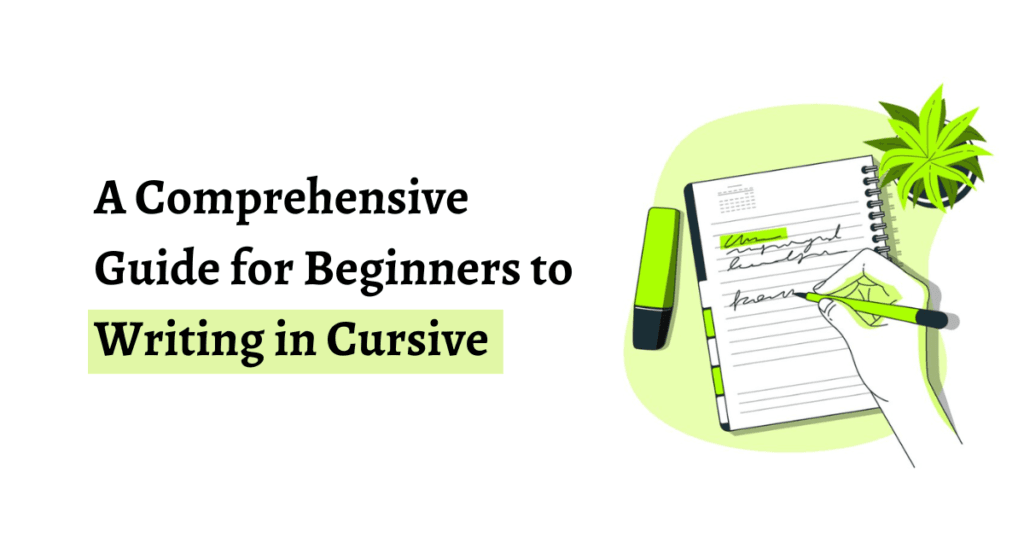Learning cursive writing is a journey that leads to a world of timeless grace and conceptual enrichment. This comprehensive guide is designed for beginners, providing a step-by-step exploration of the art of cursive. Everything is carefully demystified, from learning the basic strokes to creating attractive connections between letters.
Besides the visual allure, discover the conceptual benefits that come with this skill, enhancing not just your penmanship but also fine motor skills and language comprehension. Join us on this captivating adventure into the realm of cursive writing, where every stroke tells a story of artistry and personal expression.

What is Cursive Alphabet Writing?
Cursive alphabet writing, a timeless form of penmanship, is an elegant and fluid style of handwriting where letters are connected in a continuous, flowing manner. It’s an artful expression of communication that enhances the beauty and personal touch of written words. Beyond its aesthetic appeal, cursive offers cognitive benefits, promoting improved hand-eye coordination and fine motor skills. This intricate script has a rich historical significance, dating back centuries and evolving across various cultures.
Learning cursive requires a methodical, sequential approach that creates a special bond between the writer and the written word. Despite the rise of digital communication, the significance of cursive persists as a skill that transcends generations, preserving a tangible link to our cultural heritage. Adopting cursive is a celebration of the artistic quality of written language, which makes it a valued and important form of expression in the modern world, rather than just a nod to tradition.
Benefits of Learning Cursive Alphabet Writing
Learning cursive writing extends far beyond the fluency of a beautiful script; it provides conceptual and developmental advantages that endure throughout a lifetime. Cursive writing engages the brain through its complex strokes and continuous flow, improving hand-eye coordination and fine motor skills. Studies suggest that students who learn cursive tend to have improved reading and spelling abilities, as the connected letters promote a deeper understanding of language structure.
Cursive alphabet writing also gives communication a very personal touch and lets people express themselves with a unique flair. It’s a timeless skill that not only preserves the artistry of penmanship but also connects us to historical documents and cultural heritage. Cursive letter writing shapes minds and fosters a deeper appreciation for the written word, which is beneficial in an era where keyboards rule the scene.
A Complete Guide to Cursive Writing in 7 Easy Steps
1. Grasp the Basics with Fundamental Strokes
Learn the fundamental strokes that form the cornerstone of elegant handwriting to get your cursive writing off to a great start. Accept the simplicity of straight lines, the grace of curves, and the artful loops that will form the basis of your cursive alphabet mastery.
2. Explore the Lowercase Alphabet
Explore the lowercase alphabet, immersing yourself in the proper formation of each letter. Recognize the intricate connections between letters, as cursive’s charm lies in the seamless transitions that give it its distinctive flow. Practice these lowercase letters to build a strong foundation.
3. Take on the Uppercase Letters and Their Unique Forms
Move on to the uppercase letters, unraveling their distinct cursive forms. Take the time to practice each uppercase letter individually before integrating them into complete words. Remember, consistency in size and spacing is pivotal for achieving a polished cursive script.
4. Connect Letters Effortlessly
Master the basic concept of cursive by seamlessly connecting letters. Focus on maintaining a consistent slant and eliminating unnecessary breaks between characters. This step is crucial for achieving the fluidity that defines cursive writing.
5. Develop a Consistent Approach
Attain uniformity in your cursive script by establishing a consistent slant. Experiment with different slants to find the one that feels the most comfortable and visually attractive to you. Your writing will look more polished and cohesive with a consistent slant.
6. Work on word formation
Apply your cursive knowledge by forming words. Start with simple words and work your way up to more difficult ones. Pay extreme attention to spacing and proportions, ensuring a harmonious appearance across the entire word. This step bridges the gap between individual letters and full sentences.
7. Build Expertise Via Consistent Practise
The key to mastering cursive, including the cursive alphabet, lies in constant practice. Dedicate time each day to refine your skills. Utilize worksheets, engage in letter writing, or maintain a cursive journal to verify what you’ve learned. Consistent practice is the key to transforming cursive writing into a fluent and expressive skill.
Conclusion
Congratulations! You’ve completed this comprehensive guide to mastering cursive writing, encompassing both fundamental strokes and the intricate cursive alphabet. Accept the grace, expressiveness, and cognitive advantages of cursive writing for both your personal and business correspondence. As you continue to practice, remember that the beauty of cursive lies not just in the individual letters but in the seamless movement they perform together, creating a script uniquely yours.











